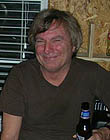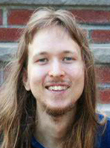|
|
 
|
|
Author
|
Topic: How to sync DTS to Mono opt. print?
|
|
|
|
|
|
|
|
|
|
|
|
|
|
|
Tom Holland
Film Handler

Posts: 15
From: Hidden Hills, CA, USA
Registered: May 2002
|
 posted 01-16-2006 11:46 AM
posted 01-16-2006 11:46 AM




The Karasync system was pure genius. Several years ago I had extensive discussions with the inventor about selling its use to Hollywood, but with repertory cinema on the wane it attracted little interest.
Here's how easily it would work in reality: Let's say a 35mm vintage IB Tech print with mono track wanted to be screened. Prior to the show, the audio track of the same movie's DVD (presumably remixed; multi-channel, Dolby, etc.) would be transferred to a hard drive inside the "black box". As the original optical mono print was projected (splices and all!) the software would instantaneously match up the old audio to the new audio on the hard drive. This would be done by high-speed sampling of the mono track, constantly looking for matches on the updated track. The audience would see the vintage Technicolor image, but seamlessly matched to state-of-the-art sound!
The inventor built a prototype at one point, which he later dismantled. In theory, and setting any potential copyright infrigement issues aside, the unit could be a small rack-mount device with a simple DVD player built in.
As I recall, interest in the original concept (ie. giving older prints better sound) was virtually non-existant in Hollywood... but there were some anti-piracy applications for the patent which were being investigated.
--Tom.
| IP: Logged
|
|
|
|
|
|
|
|
|
|
|
|
All times are Central (GMT -6:00)
|
|
Powered by Infopop Corporation
UBB.classicTM
6.3.1.2
The Film-Tech Forums are designed for various members related to the cinema industry to express their opinions, viewpoints and testimonials on various products, services and events based upon speculation, personal knowledge and factual information through use, therefore all views represented here allow no liability upon the publishers of this web site and the owners of said views assume no liability for any ill will resulting from these postings. The posts made here are for educational as well as entertainment purposes and as such anyone viewing this portion of the website must accept these views as statements of the author of that opinion
and agrees to release the authors from any and all liability.
|

 Home
Home
 Products
Products
 Store
Store
 Forum
Forum
 Warehouse
Warehouse
 Contact Us
Contact Us




 Printer-friendly view of this topic
Printer-friendly view of this topic














